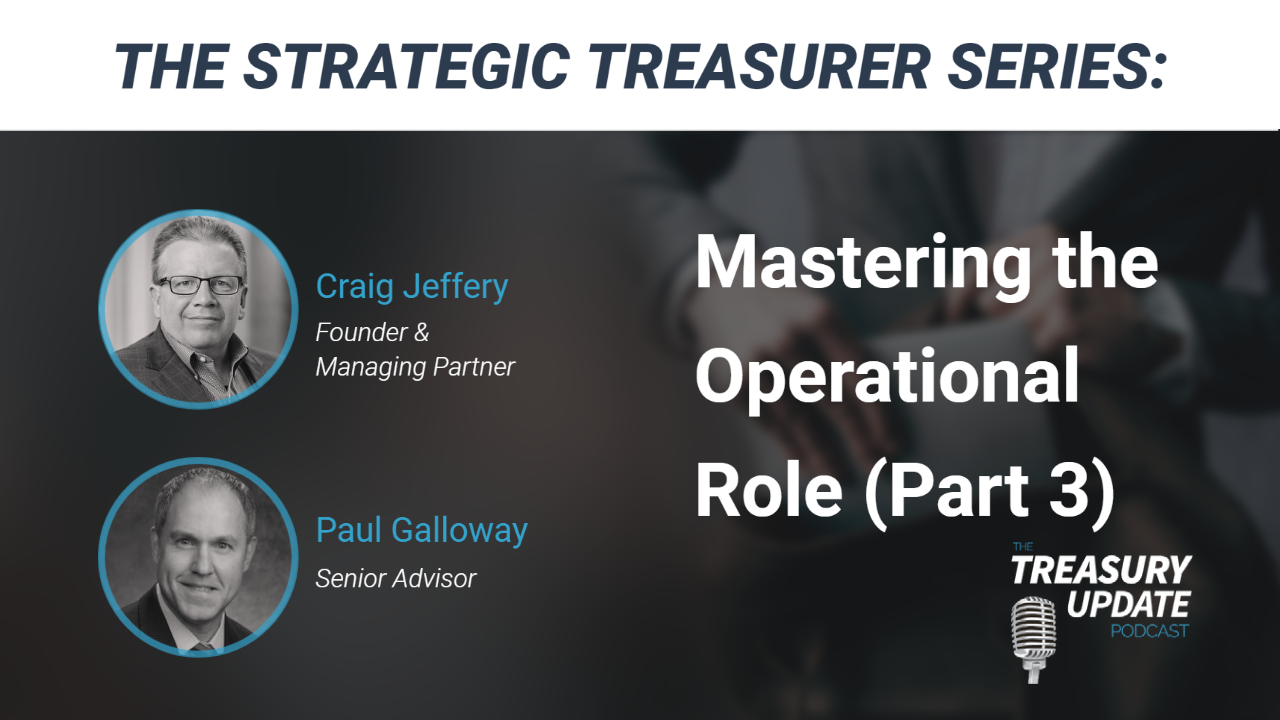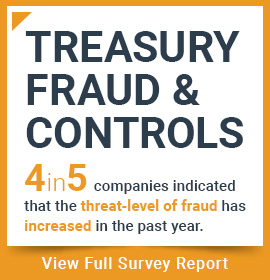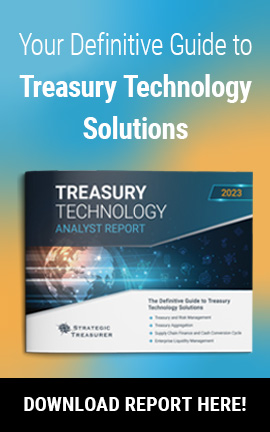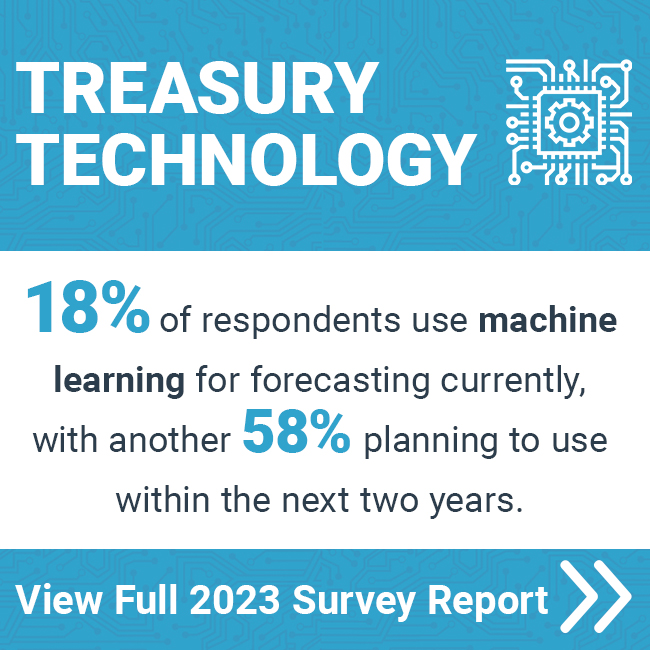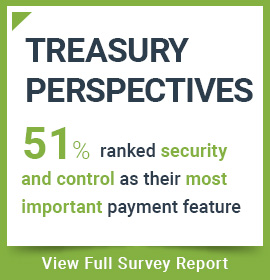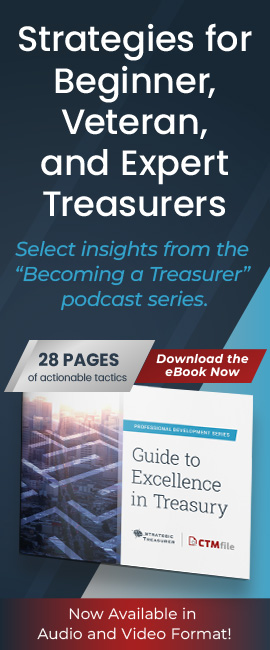
Episode 220
The Strategic Treasurer Series:
Mastering the Hybrid Role (Part 4)
This episode is Part 4 of our Strategic Treasurer Series on treasury roles. Although we are exploring different specific roles in treasury, it is often required for treasurers to wear many hats and fit into a hybrid role. Listen in as Craig Jeffery and Paul Galloway discuss the mindset needed for maintaining a hybrid role.
Host:
Craig Jeffery, Strategic Treasurer


Speaker:
Paul Galloway, Strategic Treasurer
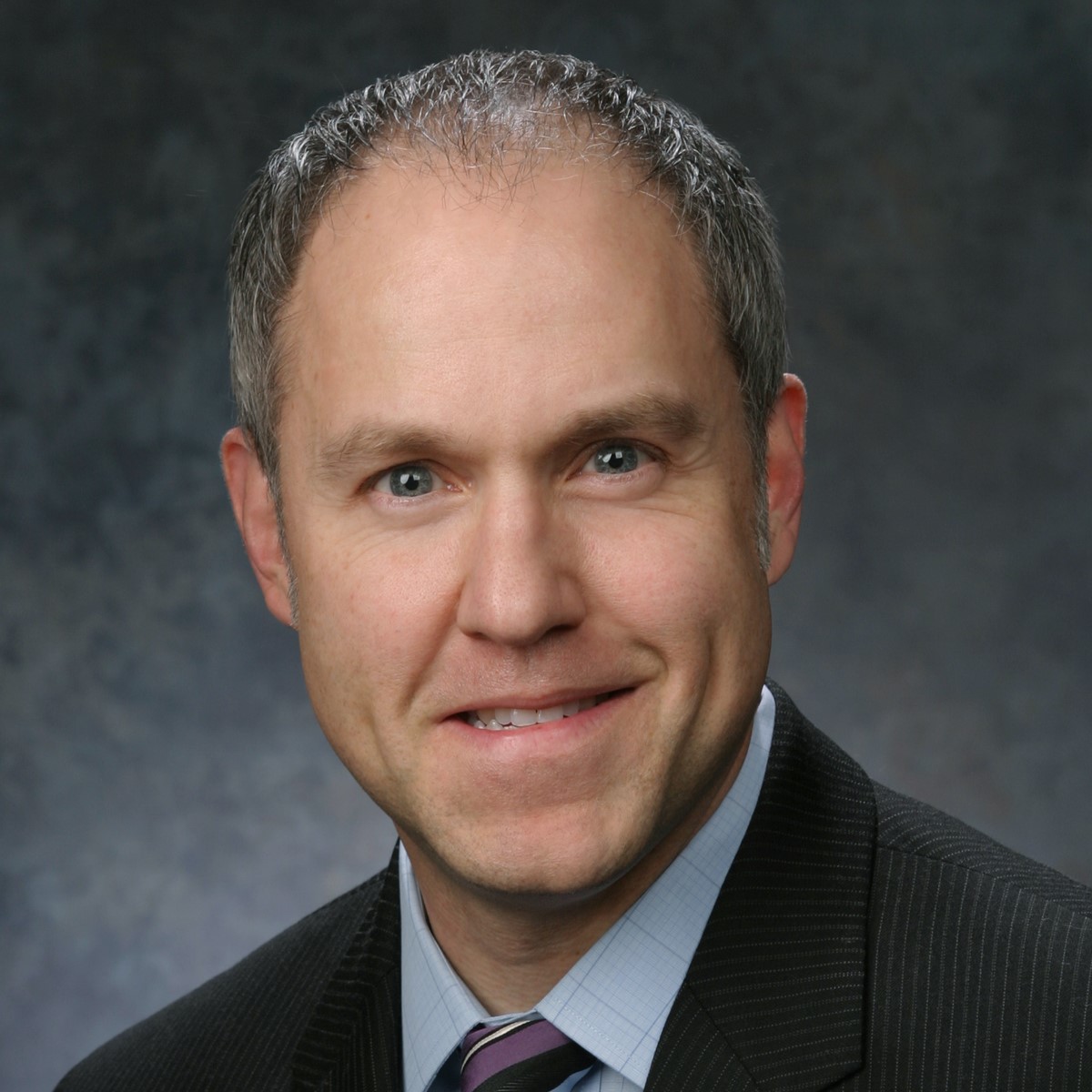

Subscribe to the Treasury Update Podcast on your favorite app!
Episode Transcription - Episode #220 - The Strategic Treasurer Series: Mastering the Hybrid Role (Part 4)
Announcer 00:04
Welcome to the Treasury Update Podcast presented by Strategic Treasurer, your source for interesting treasury news, analysis, and insights in your car, at the gym, or wherever you decide to tune it.
Craig Jeffery 00:18
Welcome to the Treasury Update Podcast. This is Craig Jeffery and I am your host for this continuing series. Today’s session is on hybrid roles in treasury. As we look at treasury roles, operational effectiveness and strategic excellence are a key part of treasury’s activities. And this short series on the treasury update podcast explores different types of roles within treasury. Some responsibilities are, by nature, highly operational, necessary and important for treasury to fulfill its mission. While other responsibilities are more strategic in nature, and require foresight, and excellence in planning and relationship management. While each position tends to be oriented heavily in one direction, there are some positions that are hybrid. What can we learn about these different activities and roles in order to be more effective in our careers, and more helpful to our organization? What assumptions should we challenge? How do we leverage our strengths and develop some of our weaknesses? This is the fourth part in our series on treasury roles, and we’re going to be discussing hybrid treasury roles. I’m joined again by Paul on this series, and he’s been a participant in each episode. So welcome back, Paul.
Paul Galloway 01:29
Thanks, Craig. Good to be back for another one.
Craig Jeffery 01:32
Let’s begin by talking about hybrid. I know we’ve, for those who’ve listened, if you’ve listened, and secondarily, you’re probably well attuned to what we mean by hybrid roles. But Paul, let’s let’s begin by talking about what are hybrid roles? What are some of the common situations where hybrid roles exist? What are they, and maybe we can flavor factor in some of the differences between larger and smaller organizations, there’s some different flavors of where organizations may have hybrid roles, maybe get us started on that.
Paul Galloway 02:04
Sure, Craig. Just kind of quick overview of what hybrid roles look like from treasurer’s perspective. It typically is partly fabricated into two parts, one part being more of an operational view, the other being more of a strategic view. And as one can expect, on the operational side, this is going to be fast paced, day to day activity that occurs, or perhaps over a period of time within a week or less, where the treasurer is actively engaged in what goes on from moving cash to providing liquidity to ensuring that all the operational aspects from front end back end or running smoothly. And working with the team to achieve that, then the strategic side of things would be more long dated, core activities engaged in more project based work or things that are geared towards making decisions for the organization, perhaps at a capital or balance sheet view or a strategic business unit view, where the treasurer does analysis and engages people within the organization and or outside the organization to achieve strategic goals. So when you think about that, between a small and a large organization, this hybrid role can look different, in the sense that in a smaller organization, Treasurer could be pulled more on the operational side and a little less on the strategic side, just because of the nature of the size of the Treasury organization itself, or the capacity within the organization to do more strategic work when they’re a smaller company. With a larger organization, there may be more opportunity where the treasurer is more strategic, and relies on the larger team that they have in place to engage in the operational side. There also can be an impact between a centralized versus decentralized Treasury platform. Have you seen anything that is different than what I’ve seen or have talked about from small organization to large organization how treasurer’s move around in hybrid overall?
Craig Jeffery 04:44
Ya know, you gave a lot of good examples. You know, sometimes the hybrid roll is hybrid within a day, and sometimes it’s hybrid during the time of year a period so smaller organizations, people have to wear many hats. So the smaller it is, the more generalist the team has to be, because they’re, they’re doing many, many duties as you get really large, there tends to be more and more specialization. You know, the strategic roles, people are focused on deals, or advisory, and other people are focused on managing the operations, let’s say front, middle, and back office, all of those activities are being accomplished by specific people. So the larger you get, it tends to be, the roles tend to be more defined on either side operational or strategic. Paul, that’s not always the case. And there’s there’s almost always hybrid roles, even in large organizations, small organizations that the switching back and forth can even be done by the treasurer, as you mentioned, but you know, once you get past a certain size, rarely is the treasurer, becoming involved in a lot of operational activities there, they might be doing some significant relationship management if there’s some troubleshooting activities. But that’s more of an escalation level. So I think your examples are, are good. And as we think about what’s most common here, you know, the fact that some roles have to wear a lot of hats, some of those hats are operational, some are strategic, some people don’t like that they like to be focused on one or two things, or they like, lots of activity, or lots of thinking and project, let’s call it project or deal based activity. And that’s not always the need in an organization. Some people like wearing a lot of hats and like being able to switch between operational strategic, I think that’s probably a lot rarer than I used to think. But that’s, that’s certainly the need in a number of organizations. So someone managing a group might be very heavily supporting them operationally, in the morning, providing coverage and backup, and then they’re meeting with bankers and working on deals, perhaps in the afternoon, maybe focused more completely full time on on deal management, you know, when a renewals coming up? So there’s, there’s a range there, Paul, I don’t know if that triggered, any other thoughts on your side?
Paul Galloway 07:07
Yeah, I definitely agree with that. And you think about, you know, this concept of wearing many hats, which, definitely, for smaller organizations, I’ve, I felt that myself, in a capacity in a role where I had to wear a lot of hats, you call it that many hat disease, it’s just a byproduct of the organization that you’re in, when you are smaller, who requires more flexibility and more ability to adjust and adapt to the environment you’re in? So these are great comments. And, you know, I guess the next thing for us to transition to be, you know, how do you find success? What does that look like in a hybrid role? You know, kind of alluded to this idea of this concept of being able to adapt or be flexible, it’s something that you have to have, you have to have the ability to do that. And these roles because they can be fast paced, and they can require you to turn on a dime, just because the organization needs you to, that’s not as easy. How do you find success doing that? Well, if it’s something that that you struggle with, and it’s, it’s something that you’re going to have to definitely work on, you can, you can reach out to other people that are in similar capacities and find out what they do and learn from them. You can talk to other people within your organization that also work in hybrid roles. Because certainly, being a treasurer isn’t the only role where you have to be hybrid. So you could talk to other people within your organization. You could research and find opportunities through webinars and so forth. But some of this is just the ability of the individual to be able to do that. And some people just naturally transition from one thing to another, and be able to juggle that. It’s not an easy or common trait to have.
Craig Jeffery 09:17
There’s that myth of, hey, I’m multitasking, you know, you that really doesn’t happen. You’re doing one or the other. And I know that’s a that’s a myth it. Some people may be yelling back at the device or listening to the podcast on. You know, it’s one thing to say I’m listening to a podcast while I’m cutting the grass. That’s, that’s not what we mean. We’re talking about items that involve quite a bit of your mind. Let’s say you’re managing the cash position or approving transfers, working on agreements, working on deals, those are things that you need to be well focused on. And so people that appear to be multitasking, I think it’s really an issue of they’re able to switch quickly their their switch latency If we can use technology terms is really good, they can switch from one to another, sometimes they can switch back and forth, or they’re answering or responding to emails while they’re doing something else. And I think knowing when you can do that is is crucial. But in these hybrid roles, you know, if you’re switching from lots of checking, making sure things are highly accurate, on an operational side are some of your activities, and then you’re focused on your managing looking at your exposures and what the policy might be, and advise the different areas in the business, you have to be able to move and think deeply, and then be able to make quick decisions that switch latency, people that you know, as I hit a person is good at multitasking, they’re really good at switching between tasks, quickly, picking things, some things up and, and putting other things down. I’m gonna give you some examples, Paul, you know, my my position here and what I have to do at our consulting and research firm, our advisory and research firm changes over time, as we pick up more things and do different things, I have to keep shifting what occurs, and there’s a certain level of operational things I have to do and just, you know, just working with my assistant. So Nikki, as we just had a discussion, it’s like, we have to have certain times set aside each week where a lot of these small update calls are with leaders of the business, we have to have opportunities for those to occur, but not blocking an hour or half hour off, to be able to handle those. And then there’s this constant, how do you move things off to someone else? So that you’re not switching between 1000 tasks a day? I mean, that’s almost impossible. Part of the mindset there is how do we how do we know what we can do? Like I find it really difficult to write in the office. Because there are so many activities, you know, in between meetings you get done earlier, it’s hard to pick up with 10 minutes before your next meeting, and continue an article you’re writing or outline your research, there’s certain things that I find I have to do, I do it from home, or I go into a conference room, or I close my office door, that allows me to focus on the I’ll just call it the strategic. Whereas other items, there’s lots of interactions, switch latency, there’s a bit of the mindset, and then there’s, then there’s the Know yourself how you can do these more quickly. I think that’s one or a couple things that I would say about that, Paul, and as you’ve gone through that, and you obviously see other people fill these hybrid roles and any other insights you have there.
Paul Galloway 12:37
There really isn’t this concept of multitasking, it’s really a person’s ability to put one thing down, switch focus to another task, or project or paper or meeting what whatever it is recording a podcast like we are right now, you know, the ability to do that requires that switch latency, as you talked about. And before our call, I was focused on looking at and reviewing slide deck and making changes and, you know, it’s like, Alright, hey, I gotta get ready for this podcast. How do I do that? Well, I just put that down, I say, Alright, I gotta do this. So it’s, it’s being able to get your mindset in a position to tackle and to do the things you got to do to get the job done. And that’s something that I feel, personally, I’m able to do. What I’ve noticed for some folks is, it’s extremely difficult for them to do that. They are challenged by switching from one thing to another, when people are brought into an organization where a person needs to be adaptive needs to have the ability to move from one thing to another quickly, and then come back to what they’ve been working on. You need to find a person that can demonstrate or has the ability to demonstrate those kinds of skills, and they need to understand themselves, what works for them and what doesn’t, you gave a great example, in terms of writing, I absolutely agree. 10 minutes in between meetings is nowhere near enough time to jump back into writing work product, you can’t do that it just doesn’t work well. You can’t be very effective at it. You gotta be able to have some time blocked to where you can give thought to it because it requires a lot of your thought process. You have to be strategic about what you’re doing. If you know yourself and you understand the environment you’re in, you’re able to manage that a lot better.
Craig Jeffery 14:51
I know I can switch quickly between operational decisions, you know, here gather enough information, make a decision or have a quick dialogue on something with someone and give them the feedback they need. Very easy to switch on the, I’ll just call it the operational side on the strategic side developing something, designing something, strategizing, I can’t switch between those nearly as rapidly. And so, you know, it’s like how you plan your day or how you think about those is becomes more important. And I, I find as things change, I have to continue to relearn that and in a different way. You know, Paul, you know, the the idea of when you switch when you have a hybrid role, where you’re switching between strategic activities, very, let’s say intensive thought, you know, thinking about things for a long period of time evaluating, analyzing, and operational, however, how are people finding ways that this helps with things like automation or structure in a group that when you have both these roles, there’s an element of that where you get to see both sides. And so you’re not, you have more of a 360 degree view, and that can help with decisions. But how does that play out from what you’ve seen?
Paul Galloway 16:05
Again, I’m gonna go back to a person’s ability to understand themselves. It’s sometimes people just know, they struggle with it. But when somebody understands what works for them, then they’re able to, I think, figure out how to adapt more easily. I know when things don’t work for me, if I’m getting bombarded, and I guess I’ll use the analogy of kind of a machine gun approach. All of a sudden, I’ve got four or five, six things coming at me all at once. And it’s almost like sensory overload because it’s like, oh, I need to respond to these things. And then I’ve got to figure out how to prioritize it. And I know, it doesn’t work for me to try tackle everything at once. I just can’t do it right, physically can’t do it, mentally can’t do it. So I’ve got a, I’ve worked out ways to figure out how to prioritize the information that’s coming at me, and figuring out what I need to address now versus later, which is not always easy. And you brought up your ability to figure out from an operational standpoint with the firm things that you have to address, and that you can tick off quickly. And things might take a little more thought and come back to it. That is a challenge. And some of it is also relationship based, meaning how you are able to influence those you work with either internally or externally, and be able to set expectations so that they’re aligned, somebody may have an expectation, hey, Craig, I sent you a request, or asked you a question, that my expectations are your respond right away. And on your end, you may be gone. Okay, this is a good question. I can’t address that right now, I need to give it a little thought. Or it could be that you’re in a meeting, you just physically can’t do it. So you have to be able to work your relationship influence others to set the tone so that there’s a common understanding of what you’re going to do and when you’re going to do it. So it does take some of that kind of effort, which is more this the soft skills associated with balancing these hybrid roles. And what’s expected.
Craig Jeffery 18:37
The other thing that comes to mind is to talk about the hybrid roles if you’re doing both types of roles. And let’s say you’re doing something, you know, maybe project oriented, you’re you’re connecting banks, or you’re planning, you’re working with it to set up your data lake and you’re reporting, the fact that you become familiar with how the different components the different Lego bot blocks are put together from a data connection and a system standpoint, etc, and how that how that works together. That gets coupled with, you know, the strategic view, what do we need to do, you know, from an analytical perspective, or from a meeting our organizational directives, like what’s what’s essential for ensuring liquidity, owning the payment process, you know, superintending the payment process and securing liquidity from from our bank partners over time, you know, when we think about both of those together, the fact that we can think broadly, like, what’s the right way to do things, as well as how to do things right how to be efficient at what I do, tends to be much more of an operational focus, you’re doing so much you want to be efficient, but then when you think broadly, the the effectiveness doing things, right, designing things, right, putting the right types of structures in place. You know, it’s much more than just people processes and technologies. It’s also structures. Design, because those In the strategic decisions, impact all of your operational activities, and your operational activities, inform all of your should inform all or most of your, many of your strategic decisions. And so that feedback loop if some of that’s in your own head, it’s, it’s easier for you to incorporate, versus just asking others about that you see both sides and you say, Well, if I design this differently, I’m going to save all this time later, I’m going to have more flexibility to provide analysis over all of these questions that come up, I don’t have to build 9 million spreadsheets. I’ve put this data into a data lake and I can use a business intelligence tool and continue to support self discovery just for dozens examples, I think the hybrid role really provides a lot of opportunities for people to look at things from a 360 degree view and do better at the strategy, and then ultimately do much better from an overall efficiency perspective.
Paul Galloway 21:00
Yeah, Craig, I agree, your comments around, you know, operational versus strategic and the opportunity to automate from an operational standpoint, there’s certainly greater opportunity for automation. To your point on the strategic side, the use of data and information and BI tools, you know, Tableau or Excel or other tools that you can utilize to extract data and information from your data lake and put it into meaningful analysis within a short time period. Certainly helps with the automation side, I think one of the other skills, the hybrid role is focused on strategic requires is the ability to anticipate relative to strategy of the organization, of course, you had to have to have the time to put towards the anticipatory side of things. But if you have somebody in that role that’s able to anticipate what matters and is able to position themselves or when they get the call, Hey, I need this kind of work done. And they say, Oh, no problem, I’ve already got some of this, sitting in the data lake or I have some tool already running that provides that type of analysis. So I can go in, you can input data and information, or this request, and be able to generate analysis within a shorter time period. So a little bit more of an automated process versus ad hoc, where it’s one off and requires more thought, more time, more effort, but it’s certainly more difficult on the strategic side to do that.
Craig Jeffery 22:53
Thanks for your comments. And, and thanks for talking through these different issues about treasury roles, operational, strategic and hybrid roles in this mini series. I’ve I’ve enjoyed it. I’ve learned some things. Thanks for doing this.
Paul Galloway 23:08
Thanks, Craig. Always, always a pleasure.
Announcer 23:13
You’ve reached the end of another episode of the Treasury Update Podcast. Be sure to follow Strategic Treasurer on LinkedIn. Just search for Strategic Treasurer. This podcast is provided for informational purposes only, and statements made by Strategic Treasurer LLC on this podcast are not intended as legal, business, consulting, or tax advice. For more information, visit and bookmark StrategicTreasurer.com.
Related Resources
Payment Security & Fraud Prevention: The Principles of SECURE CLAMPS eBook
This book brings you twelve payment security principles, distilled from one portion of Strategic Treasurer’s SecureTreasury™ course. The cores of these twelve foundational principles for securing your payment processes remain consistent amidst constantly evolving threats and leading practices.
Mastering the Operational Role (Part 3)
Our previous episode on treasury roles covered the differences between the strategic and operational roles. Today, we will continue the discussion by looking at mastering the operations side. Your daily operational responsibilities are the financial backbone of your business. Craig Jeffery and Paul Galloway discuss the most common operational roles and activities, what mindset to have to succeed in these roles, and what you need to know to maintain efficiency.





![Payment Security & Fraud Prevention [eBook] Payment Security & Fraud Prevention [eBook]](https://strategictreasurer.com/wp-content/uploads/07-Secure-Clamps-eBook.png)
